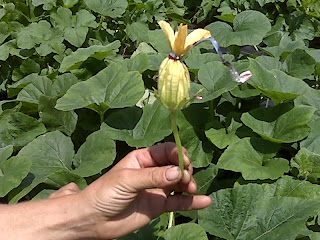I drifted in just after lunchtime, introduced myself, changed out of my bike gear (spandex is good for biking but not so much for walking through thistle patches, which are quite abundant on midwestern farms, incidentally), and not 20 minutes after my arrival was picking tomatillos and chatting away with Emily. I learned as we worked, and later while we cooked dinner together at her house the next two evenings, that my picking partner was the only other full-time worker on the farm. With dozens of heirloom varieties bursting with color amid the foliage across the farm -- tomatoes, sweet and hot peppers, leeks, okra, strawberries, beans, and more -- I was amazed at how much the farm could produce with such a small workforce. Dan's wife helps with some of the work at the various markets they supply, but she has a job off the farm so the lion's share of the manual labor falls on Dan's shoulders. There are a few folks who do work shares a few hours per week in exchange for food during the growing season, but with over 100 shares for the year-round CSA and multiple farmers markets, out of necessity Dan has to be creative and efficient wherever possible. All the while he refuses to sacrifice the quality or diversity of his crops.
In many ways, Dan epitomizes the kind of thoughtful observation and connection to the land that agriculture lost when it became industrialized...and what it needs to relearn. He knows his land and his crops down to the most minute detail, but he looks outward, too. He was curious about other farms I'd visited: what kinds of cover crops they used, how they managed weeds (and if everyone had quite so many -- they generally did), what varieties of garlic they grew. As a general practice, he regularly evaluates his methods to see if there are things he could be doing better, incorporating ideas from his own observations, from what he's read, from his peers. On occasion he'll come up with something quite novel.
Take his method for washing greens, for instance. He grows quite a cornucopia of lettuce greens -- I know because I helped to harvest at least 5 or 6 varieties -- and is meticulous about rinsing and storing them for his customers. The same goes for kale -- at least 3 varieties (including my favorite, dinosaur kale). Dan and I stood next to each other at the deep sinks, talking as we worked, soaking everything in the first tank, picking out any leaves that were questionable before giving them a soak in the second sink. But the best part was the drying. Dan had bought a second-hand washing machine recently. He tossed the double-washed greens in, flipped the machine on the spin cycle, and about 15 seconds later our greens were crisp and ready for bagging. It was essentially a giant salad spinner -- you know, like the kind your mom uses. Now the greens would not be in danger of getting soggy and we didn't have to crank bucket after bucket of the stuff in the usual, small spinners. This is the kind of practical ingenuity I keep encountering on the farms I have been working on, the kind of thing the Podolls would have come up with in "Deeply Rooted" (which I just finished reading last night). Whether for philosophical or economic reasons, these farmers are constantly inventing new ways to do things, working to minimize the oil-dependent energy and chemical use in their practices, and quietly, slowly succeeding.
I departed around lunchtime on Friday for Goshen, where I would be staying with Emily's friend Joe and checking out the farmers market before at last trucking myself (most of the way) to La Porte on Saturday. Before I left, I teased Dan that he needed to take a vacation. It'd been something like 5 years since the last one, he admitted, but with so many folks counting on him for fresh, local food each week, how could he take time off? "I mean, they depend on me. Plus, all I'd want to do was be back tinkering with some of the stuff on the farm I never seem to get to, anyway," he smiled. "That reminds me, I need to look into a few more garlic varieties for next year. And I need to figure out a way to cut down on weeds in the melon patch. And I keep meaning to revise that cookbook for the CSA members...."
Sent from my Verizon Wireless BlackBerry

















